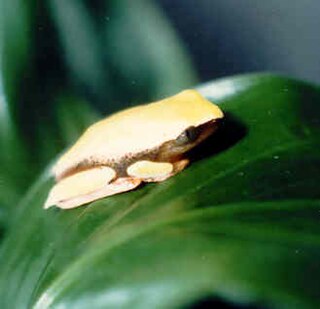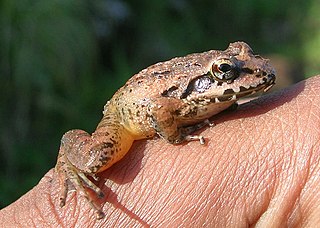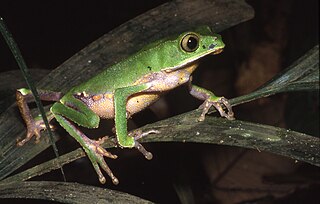
Amphibians are ectothermic, anamniotic, four-limbed vertebrate animals that constitute the class Amphibia. They are a paraphyletic group encompassing all tetrapods excluding the amniotes, and all extant amphibians belong to the subclass Lissamphibia. Evolved to be mostly semiaquatic, amphibians have adapted to inhabit a wide variety of habitats, with most species living in freshwater, wetland or terrestrial ecosystems. Their life cycle typically starts out as aquatic larvae with gills known as tadpoles, but some species have developed behavioural adaptations to bypass this.

A frog is any member of a diverse and largely carnivorous group of short-bodied, tailless amphibians composing the order Anura. The oldest fossil "proto-frog" Triadobatrachus is known from the Early Triassic of Madagascar, but molecular clock dating suggests their split from other amphibians may extend further back to the Permian, 265 million years ago. Frogs are widely distributed, ranging from the tropics to subarctic regions, but the greatest concentration of species diversity is in tropical rainforest. Frogs account for around 88% of extant amphibian species. They are also one of the five most diverse vertebrate orders. Warty frog species tend to be called toads, but the distinction between frogs and toads is informal, not from taxonomy or evolutionary history.

Hylidae is a wide-ranging family of frogs commonly referred to as "tree frogs and their allies". However, the hylids include a diversity of frog species, many of which do not live in trees, but are terrestrial or semiaquatic.

Agalychnis callidryas, commonly known as the red-eyed tree frog, is a species of frog in the subfamily Phyllomedusinae. It is native to forests from Central America to north-western South America. This species is known for its bright coloration, namely its vibrant green body with blue and yellow stripes on the side. It has a white underside, brightly red and orange colored feet, and is named after its distinctive bright red eyes.

The glass frogs belong to the amphibian family Centrolenidae. While the general background coloration of most glass frogs is primarily lime green, the abdominal skin of some members of this family is transparent and translucent, giving the glass frog its common name. The internal viscera, including the heart, liver, and gastrointestinal tract, are visible through the skin. When active their blood makes them visible; when sleeping most of the blood is concealed in the liver, hiding them. Glass frogs are arboreal, living mainly in trees, and only come out for mating season. Their transparency conceals them very effectively when sleeping on a green leaf, as they habitually do.

The eastern dwarf tree frog, also known as the eastern sedge-frog, is a species of tree frog. It is a small and very common frog and found on the eastern coast of Australia, from around Cairns, Queensland, to around Ulladulla, New South Wales. Individual frogs of this species are often found elsewhere, having been accidentally relocated by transported fruit boxes. Confirmed sightings of breeding pairs have confirmed their survival in Victoria's cooler climate.

Phrynomedusa is a genus of tree frogs from the Southeast and South regions in Brazil. They were formerly considered to be part of the genus Phyllomedusa, as the "Phyllomedusa fimbriata group". Common names colored leaf frogs and monkey frogs have been coined for them.

Phyllobates bicolor, or more commonly referred to as the Black-legged poison dart frog, is the world's second-most toxic dart frog. Under the genus Phyllobates, this organism is often mistaken as Phyllobates terribilis, the golden poison frog, as both are morphologically similar. However, Phyllobatesbicolor is identifiable by the yellow or orange body and black or dark blue forelimbs and hindlegs, hence the name black-legged dart frog. Phyllobates bicolor are commonly found in tropical forests of the Chocó region of Colombia. The diurnal frogs live along the rainforest ground near streams or puddles that form. Notably, P. bicolor is a member of the family Dendrobatidae, or poison dart frog. P. bicolor, along with the rest of the Phyllobates species, produce a neurotoxin known as a batrachotoxin that inhibits specific transmembrane channels in cells. Due to this highly deadly toxin that the frogs secrete, many indigenous groups of the Colombian rainforest have extracted the toxins to create poison tipped darts used for hunting. During the breeding period, P. bicolor emits high pitched single notes as a mating call. As in all poison dart frogs, it is common for the father of tadpoles to carry the offspring on his back until they reach a suitable location for the tadpoles to develop. P. bicolor is an endangered species according to the IUCN red list. Currently, deforestation, habitat loss, and pollution pose the biggest threat to the species. Limited conservation efforts have been attempted to prevent further damage to the species. Despite this, there are still institutions such as the Baltimore National Aquarium in Baltimore, Maryland and the Tatamá National Natural Park in Colombia that are engaged in P. bicolor conservation efforts such as captive breeding.

Indirana semipalmata is a species of frog endemic to the Western Ghats region of southern India. They are small frogs, reaching lengths of about 36 mm (1.4 in) from snout to vent. The species breeds during the monsoons, laying their eggs on moist rocks and tree bark. Their tadpoles are terrestrial – hatching, feeding, and undergoing metamorphosis without ever entering any standing bodies of water.

Phyllomedusa burmeisteri, also known as Burmeister's leaf frog and common walking leaf frog, is a species of frog native to the Atlantic Forest biome in Brazil.

Phyllomedusa bicolor, the giant leaf frog, bicolor tree-frog, giant monkey frog, or waxy-monkey treefrog, is a species of leaf frog. It can be found in the Amazon basin of Brazil, Colombia (Amazonas), Bolivia, and Peru, and can also be found in the Guianan Region of Venezuela and the Guianas, and in Cerrado of the state of Maranhão in Brazil.

Phyllomedusa sauvagii, the waxy monkey leaf frog or waxy monkey tree frog, is a species of frog in the subfamily Phyllomedusinae. It is native to South America, where it occurs in Argentina, Bolivia, Paraguay and Brazil. This species is arboreal, living in the vegetation of the Gran Chaco.

Hyalinobatrachium fleischmanni, also known as Fleischmann's glass frog or the northern glass frog, is a species of frog in the family Centrolenidae. It is found in the tropical Americas from southern Mexico to Ecuador. Specifically, these frogs occur in Mexico, Belize, Costa Rica, El Salvador, Guatemala, Honduras, Nicaragua, and Panama, Colombia, and Ecuador. Notice that this and related species have often been confused with each other, and the exact distribution depends on the source. This frog tends to have green skin, pale yellowish spots, yellow fingertips and translucent skin covering its stomach.

Dendropsophus ebraccatus, also known as the hourglass treefrog, referring to the golden-brown hourglass shape seen surrounded by skin yellow on its back. Their underbellies are yellow. Their arms and lower legs usually display bold patterns while their upper legs or thighs are light yellow giving them the appearance of wearing no pants. The species name "ebraccata" translates to "without trousers" in Latin.

Agalychnis lemur, the lemur leaf frog or lemur frog, is a species of frog in the subfamily Phyllomedusinae. It is found in Costa Rica, Panama, and adjacent northwestern Colombia. It is classed as Critically Endangered and threatened by the fungal disease chytridiomycosis.

Callimedusa tomopterna, the tiger-striped tree frog, is a species of frog in the subfamily Phyllomedusinae. It is found in northern South America in the Upper Amazon Basin of Bolivia, Peru, Ecuador, and Colombia, Amazonian Brazil, and the Guianas from southeastern Venezuela to French Guiana. It might represent more than one species.

Phyllomedusa trinitatis, known as the leaf-nesting frog, Trinidadian leaf frog, or Trinidadian monkey frog, is a species of frog in the subfamily Phyllomedusinae. It is found in Venezuela and the island of Trinidad. It is threatened by habitat loss.

The white-lined leaf frog is a species of frog in the subfamily Phyllomedusinae. It is found in northern South America. Its natural habitats are subtropical or tropical moist lowland forest, subtropical or tropical swampland, rivers, and freshwater marshes. It is threatened by habitat loss.

The Ranoidea are a superfamily of frogs in the order Anura. Members of this superfamily are characterised by having the pectoral girdle fused into a single complex unit, having no ribs, and using an axillary grip during amplexus. The larvae have a single spiracle on the left side and complex mouthparts, or in some species, undergo direct development. The taxonomy of these families has been under heavy debate for many years. In recent studies, molecular data has been used to better identify the phylogentic relationships of these frogs, rearranging and introducing new subfamilies to better distinguish between large groups of frogs.

Kambo, also known as vacina-do-sapo, or sapo, is the dried skin secretions of the kambô, a species of frog, used as a transdermal medicine. No scientific evidence supports its effectiveness.






















